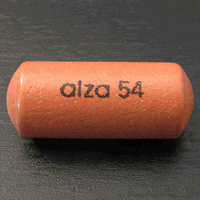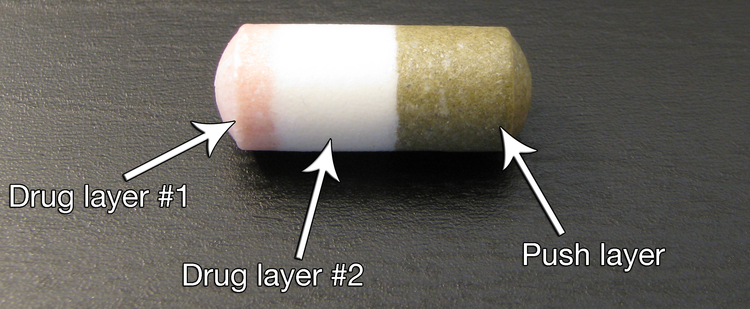Osmotic-controlled release oral delivery system

The osmotic-controlled release oral delivery system (OROS) is an advanced
Rationale
Pros and cons
Osmotic release systems have a number of major advantages over other controlled-release mechanisms. They are significantly less affected by factors such as pH, food intake, GI motility, and differing intestinal environments. Using an osmotic pump to deliver drugs has additional inherent advantages regarding control over drug delivery rates. This allows for much more precise drug delivery over an extended period of time, which results in much more predictable pharmacokinetics. However, osmotic release systems are relatively complicated, somewhat difficult to manufacture, and may cause irritation or even blockage of the GI tract due to prolonged release of irritating drugs from the non-deformable tablet.[1][4][5][6][7][8][9]
Oral osmotic release systems
Single-layer

The Elementary Osmotic Pump (EOP) was developed by
Multi-layer

Both the EOP and CPOP were relatively simple designs, and were limited by their inability to deliver poorly soluble drugs.[1] This led to the development of an additional internal "push layer" composed of material (a swellable polymer) that would expand as it absorbed water, which then pushed the drug layer (which incorporates a viscous polymer for suspension of poorly soluble drugs) out of the exit hole at a controlled rate.[1][4] Osmotic agents such as sodium chloride, potassium chloride, or xylitol are added to both the drug and push layers to increase the osmotic pressure.[1][4][5] The initial design developed in 1982 by ALZA researchers was designated the Push-Pull Osmotic Pump (PPOP), and Procardia XL (nifedipine) was one of the first drugs to utilize this PPOP design.[1][2]

In the early 1990s, an ALZA-funded research program began to develop a new dosage form of methylphenidate for the treatment of children with attention deficit hyperactivity disorder (ADHD).[14] Methylphenidate's short half-life required multiple doses to be administered each day to attain long-lasting coverage, which made it an ideal candidate for the OROS technology. Multiple candidate pharmacokinetic profiles were evaluated and tested in an attempt to determine the optimal way to deliver the drug, which was especially important given the puzzling failure of an existing extended-release formulation of methylphenidate (Ritalin SR) to act as expected. The zero-order (flat) release profile that the PPOP was optimal at delivering failed to maintain its efficacy over time, which suggested that acute tolerance to methylphenidate formed over the course of the day. This explained why Ritalin SR was inferior to twice-daily Ritalin IR, and led to the hypothesis that an ascending pattern of drug delivery was necessary to maintain clinical effect. Trials designed to test this hypothesis were successful, and ALZA subsequently developed a modified PPOP design that utilized an overcoat of methylphenidate designed to release immediately and rapidly raise serum levels, followed by 10 hours of first-order (ascending) drug delivery from the modified PPOP design. This design was called the Push-Stick Osmotic Pump (PSOP), and utilized two separate drug layers with different concentrations of methylphenidate in addition to the (now quite robust) push layer.[1][14]

List of OROS medications
OROS medications include:[1][3][4][7]
- Acutrim (phenylpropanolamine)
- Adalat OROS (nifedipine)
- Alpress LP (prazosin)
- Cardura XL (doxazosin)
- Concerta (methylphenidate)
- Covera HS (verapamil)
- Ditropan XL/Lyrinel XL (oxybutynin)
- Dynacirc CR (isradipine)
- Efidac 24 (chlorpheniramine, pseudoephedrine)
- Exalgo/Jurnista (hydromorphone)
- Glucotrol XL (glipizide)
- Invega (paliperidone)
- Minipress XL (prazosin)
- Procardia XL (nifedipine)
- Sudafed 24 (pseudoephedrine)
- Tegretol XR (carbamazepine)
- Volmax (salbutamol)
References
- ^ PMID 19602438.
- ^ S2CID 31442663.
- ^ S2CID 42490425.
- ^ PMID 21486532.
- ^ S2CID 35670161.
- S2CID 1838636.
- ^ S2CID 35424637.
- S2CID 33413277.
- S2CID 25994524.
- PMID 1510.
- PMID 7248427.
- PMID 6851623.
- ^ Haslam, John L.; Rork, Gerald S. "Controlled porosity osmotic pump". Google Patents. United States Patent and Trademark Office. Retrieved 19 March 2016.
- ^ PMID 12578439.





